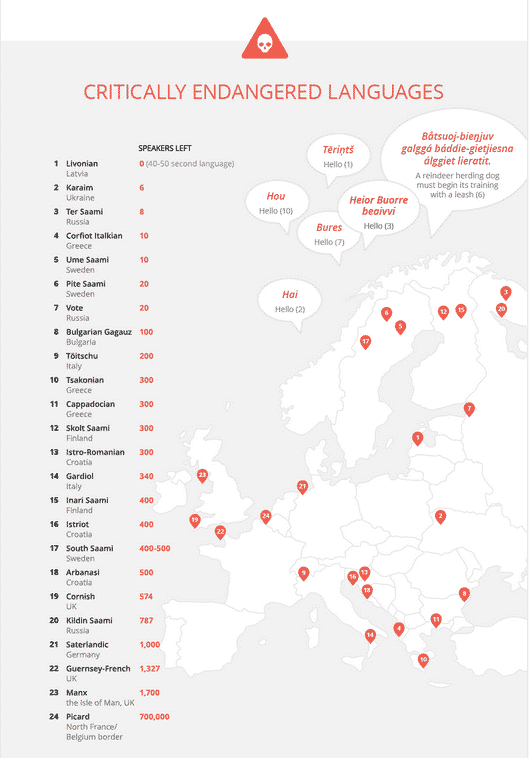With the latest things, old things – which once upon a time had great demand – become obsolete. And when some things become obsolete or become useless, we abandon those; that’s normal and natural. This is also true for languages. According to a new list, 33 European languages are now in danger. They may extinct any time.
The 33 European languages in danger and may extinct any time are:
Critically endangered European languages (number of speakers)
- Gottscheerisch, Kočevje in Slovenia (unknown)
- Ter Sami, Lviv in Russia (6-11)
- Karaim, Galicia in Ukraine (6)
- Pite Sami, Arjeplog County in Sweden (fewer than 10)
- Ume Sami, Arvidsjaur County in Sweden (fewer than 10)
- Votic, West of St Petersburg in Russia (20)
- Gagauz, Deliorman in Bulgaria (100)
- Töitschu, Issime in Italy (200)
- Cappadocian, Kavala in Greece (300)
- Tsakonian, Leonidio in Greece (300)
- Cornish, Cornwall (574)
- Manx, Isle of Man, UK Crown Dependency (The last first-language speaker died in 1974)
- Livonian, Courland in Latvia (The last first-language speaker died in 2013)
Severely endangered European languages (number of speakers)
- Champenois, Champagne in France (unknown)
- Skolt Sami, Lapland in Finland (300)
- Istro-Romanian, Mount Ucka in Croatia (300)
- Gardiol, Calabria in Italy (340)
- Inari Sami, Lapland in Finland (400)
- South Sami, Vilhelmia in Norway/Sweden (500)
- Kildin Sami, Umba in Russia (787)
- Saterlandic, Lower Saxony in Germany (1,000)
- Guernsey French, Guernsey, UK Crown Dependency (1,327)
- Jersey French, Jersey, UK Crown Dependency (2,000)
- Molise Croatian, Campobasso in Italy (around 3,000)
- Franc-Comtou, Besancon in France (4,000)
- North Frisian, Schleswig-Holstein in Germany (10,000)
- Lorrain, La Gaume in Belgium (20,000)
- Bourguignon, Bourgogne in France (50,000)
- Breton, Lower Brittany in France (300,000)
- Gallo, Upper Brittany in France (around 300,000)
- Lemosin, Limousin in France (around 400,000)
- Picard, Nord-Pas-de-Calais in France (around 600,000)
- Auvergnat, Auvergne in France (around 1,315,000)
Christopher Moseley at the UCL School of Slavonic and East European Studies identified 13 critically endangered languages and a further 20 that are severely endangered, with Livonian, from the Latvian region of Dundaga, deemed most at risk. Moseley has noted a concerted effort to revive the Manx, used on the Isle of Man, and Cornish, spoken in Cornwall in south west England, and believes these two languages could be saved.
Jersey French (Jèrriais) and Guernsey French (Guernésiais) are two of the four British dialects in peril, spoken on the islands of the same names, while Manx, used on the Isle of Man, and Cornish, spoken in Cornwall in south west England, are deemed critically endangered. Howev
According to Adrian Cain, the language development officer at Culture Vannin, the Manx heritage foundation, “In the 40 years since the last traditional native speaker of Manx died, the language has seen a remarkable turnaround in its fortunes. It is hoped that this success story can be used as an example of what can be done to promote, support and maintain critically endangered minority languages and cultures.”
On the other hand, UNESCO have predicted that half of the world’s 6,000+ languages will disappear by the end of the century, but linguistics experts think that social media might help preserve some dialects. Facebook allows users to request a new language through the site and many communities are using it to try and keep certain languages alive.
Source: Mashable
Thanks To: i100
[ttjad keyword=”verizon-wireless-contract-phone”]





